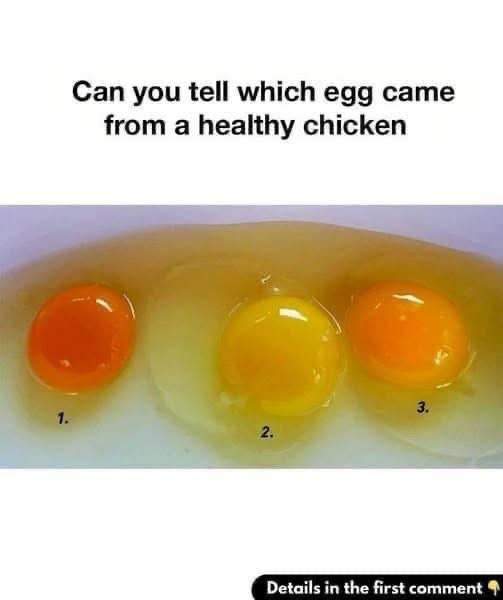Excellent question! While it’s impossible to be 100% certain without laboratory testing, there are several strong visual and tactile indicators you can use to assess the freshness and likely health of a chicken based on its egg.
Here’s a breakdown of what to look for, from the outside in.
1. The Shell
A healthy egg from a healthy chicken will have a shell that is:
· Clean: Free of cracks and major stains or debris. (Note: Occasionally, a perfectly healthy hen might lay an egg with a little dirt or straw on it, but a very dirty or stained shell can indicate unsanitary living conditions).
· Strong and Intact: It should not feel thin, brittle, or rubbery. A strong shell indicates a hen with a good calcium-rich diet.
· Matte, not Glossy: A very shiny or glossy shell can sometimes be a sign of age.
2. The Yolk (The Most Telling Sign)
When you crack the egg open, the yolk is a major indicator of the hen’s diet and health.
· Color: A vibrant, deep orange or golden yellow yolk is a very strong sign of a healthy hen. This color comes from carotenoids in her diet, which she would get from foraging on grass, insects, and eating nutrient-rich feed (like marigolds or corn). A pale, wan yellow yolk often indicates a hen fed a less nutritious, grain-only diet.
· Shape and Height: The yolk should be round, domed, and sit high above the white. It should be firm enough that it doesn’t easily break. A flat, watery, or easily broken yolk suggests an older egg or a less healthy hen.
3. The Egg White (Albumen)
The egg white provides clues about the egg’s freshness, which is linked to the hen’s health when the egg is new.
· Thick White: A fresh, healthy egg will have a thick, gelatinous layer of egg white that closely surrounds the yolk. This is called the “inner thick albumen.”
· Clear, not Cloudy: The white should be clear and not cloudy. (Note: Very fresh eggs can sometimes be slightly cloudy due to high carbon dioxide content, which is also a sign of freshness. Cloudiness in older eggs is a bad sign).
· Minimal Watery White: There will be a thinner, outer layer of white, but it should not be excessively runny and watery. A very watery white is a sign of an old egg, as the thick white breaks down over time.
4. Other Internal Signs
· The Chalazae: Those two white, rope-like strands attached to the yolk. Pronounced “kuh-LAY-zee,” these anchor the yolk in the center of the egg. Prominent, strong chalazae are a sign of a very fresh egg from a healthy hen. They dissolve as the egg ages.
· No Unusual Odors: A fresh, healthy egg should have a neutral, mild smell. Any sour, foul, or unpleasant odor is a definite sign of spoilage or contamination.
· No Blood or Meat Spots: While small blood spots are natural and harmless ( caused by a ruptured blood vessel during ovulation), their complete absence is generally preferred and can be a sign of consistent breeding and health.
—
Quick Comparison Table: Healthy vs. Less Healthy Egg
Feature Healthy, Fresh Egg Less Healthy or Old Egg
Yolk Color Deep orange or golden yellow Pale yellow
Yolk Shape Round, domed, and stands tall Flat, breaks easily
Egg White Thick, gelatinous, clear Thin, watery, runny
Chalazae Prominent and visible Barely visible or absent
Shell Clean, strong, matte finish Thin, cracked, stained, or glossy
How to Perform the Float Test (For Freshness)
This is a great test for freshness, which is a proxy for health if the egg is new.
1. Fill a bowl with cold water.
2. Gently place the egg in the water.
· Fresh Egg (Sinks): Lies horizontally on the bottom. This is the freshest.
· Still Good Egg (Stands Up): Sinks but stands on one end. It’s older but still safe to eat.
· Bad Egg (Floats): Floats to the top. The air cell inside has enlarged over time, indicating it’s old and should be discarded.
Conclusion: The single best indicator of a healthy chicken is a egg with a strong, clean shell that, when cracked open, reveals a vibrant, dark orange, domed yolk surrounded by a thick, gelatinous egg white.
Often, eggs that fit this description come from pasture-raised or free-range hens who have access to a diverse, natural diet. While not a guarantee, these eggs are far more likely to have come from a healthy and well-cared-for chicken.
